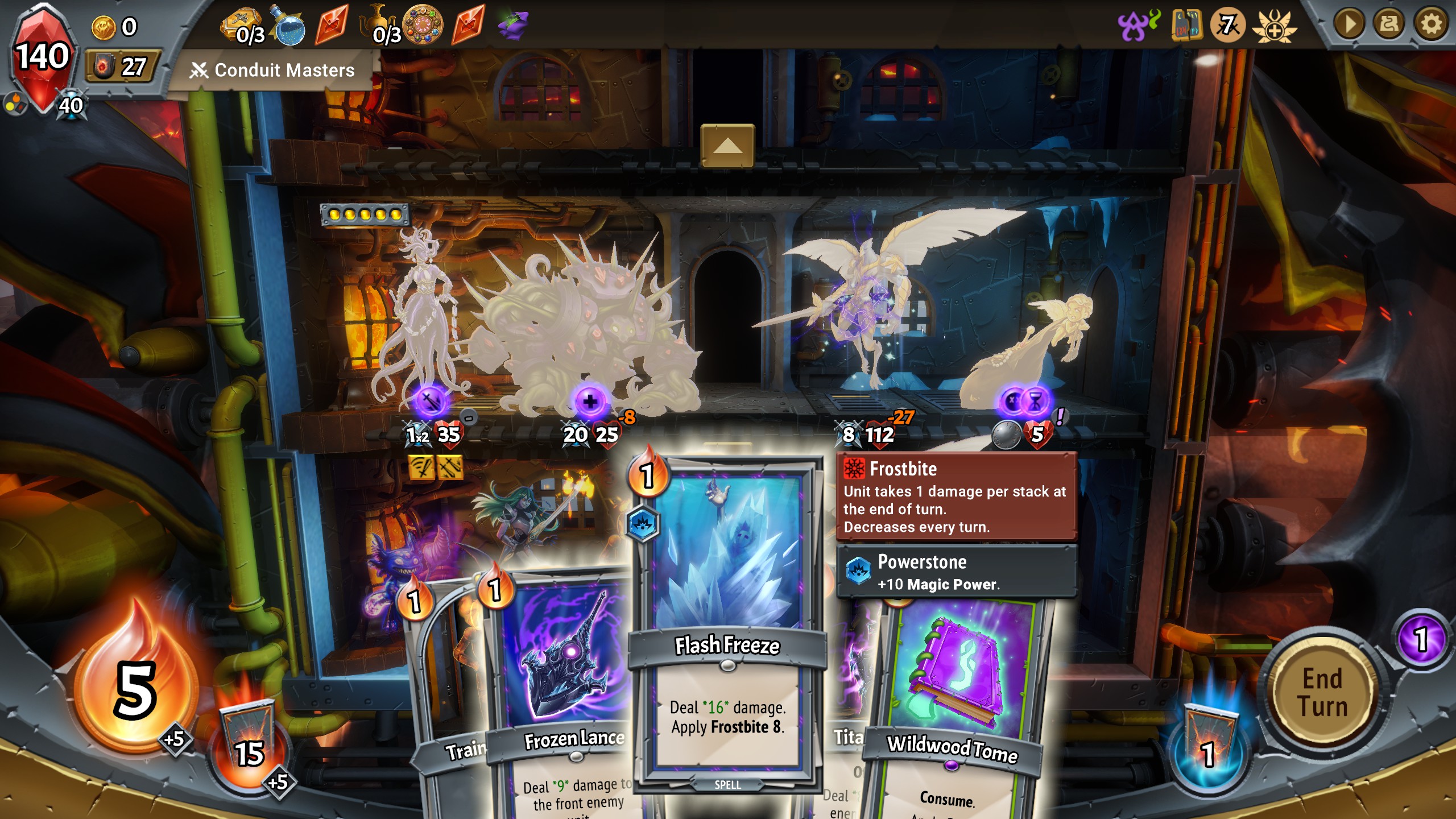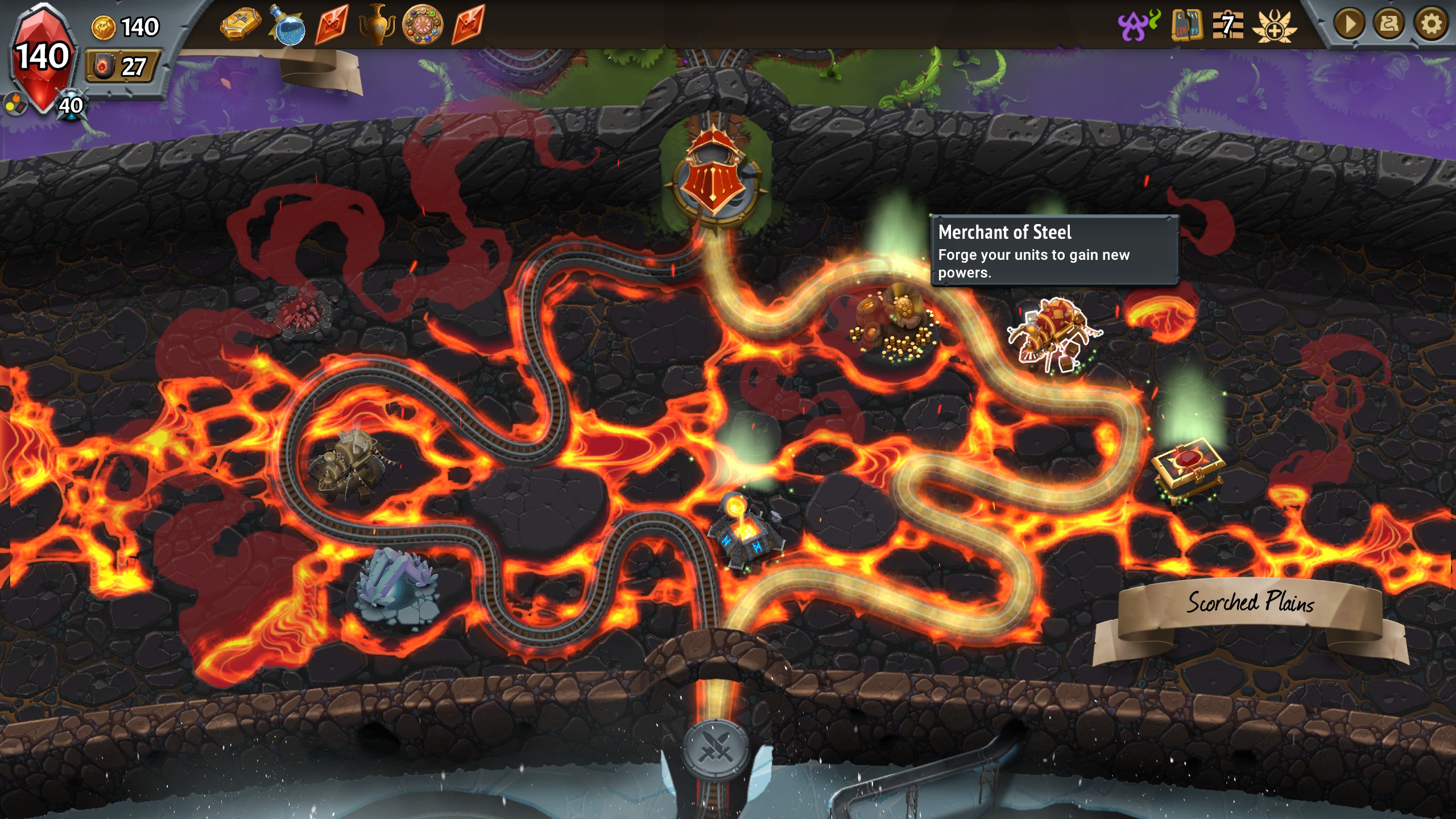Monster Train is a deckbuilder that tries to do it all and actually pulls it off
Much more than just a Slay the Spire clone.

Monster Train isn't a sequel, but the way it builds on Slay the Spire and other roguelike-meets-deckbuilder card games kind of makes it feel like one. It reminds me of how Doom Eternal piles on more and more things you have to juggle in combat, making Doom 2016 look calm and simplistic by comparison.
After just a few runs in Monster Train I was fighting bosses with more than 1000 hit points, leveling up three separate "clans" of card types, and increasing the game difficulty by starting at a higher "covenant" rank, all while still figuring out the basic strategy of this card game. It's a little bit messy and a little bit overwhelming, but also the rare case where piling on more and more features really does make for an excellent game.
The gist of Monster Train is that it's a roguelike deckbuilder: As overseer of the minions of Hell, you're the conductor of a fiery train speeding towards Hell's heart to relight its flame, which has been extinguished by some real jerk angels from Heaven. Unlike in Slay the Spire, where you control a single character, the setup here is a bit more like Magic the Gathering, with a dash of tower defense thrown in. You play cards to deploy minions on three levels of the train, and in each battle enemies enter at the bottom and move their way upwards towards the fourth floor, where your Pyre sits. That's your HP, so if the Pyre is destroyed, you lose.
Decks are a bit like Magic, too, in that before each run you choose a primary and a secondary clan. The starter clans, the Hellhorned and Awoken, are basically Red and Green, demons mixed with direct damage fireball spells, and sentient plants that can amass big pools of health. Positioning your units is a big part of the strategy, because attacks always pile up on the front unit of a row until it's dead. The setup only takes a few minutes to understand, but there's deep strategic potential in a decision as simple as which row of the tower to place a unit, and whether it should go in front of or behind another one.
The structure of Monster Train will otherwise not be a surprise if you've played any roguelike card game released in the last few years. Progression makes you choose between splitting paths, one side leading to a shop where you can upgrade your units, the other to more gold and an artifact that offers a powerful buff. There are random points of interest that can reward you with a new card or riches, but with some risk attached. Compared to Slay the Spire, there are fewer fights, but each is longer and more involved. It's a fun rhythm, where you're guaranteed some nice rewards between each battle, and basic upgrades to your cards are cheap enough that you'll get to do a lot of them.

It's almost exhausting how much is going on in Monster Train, though. Look at its menus, and it feels like a game designed by someone who created a checklist called Every Roguelike Feature and then set about building a game around them. This is a game desperate to cover every possible way you might want to play it, and to keep you engaged with new permutations and unlocks for as long as possible. This isn't a bad thing so much as it is, just, a lot of stuff:
- A timer for each run, presumably built for speedrunners
- Daily challenges with leaderboards
- Custom challenges - Make your own permutation of decks and modifiers for other players to compete with
- Multiplayer, where you race other players through a run
- Detailed run summaries with stats and the ability to copy a link to share the run details with other players
- Five different clans (aka deck types), for 25 possible primary/secondary combinations
- A Champion card for each clan, a uniquely powerful unit with special upgrade options
- Clanless cards
- Leveling up each clan to unlock new cards
- "Mastering" cards (I don't even know what this means yet)
- Leveling up 25 covenant ranks, each one making the game harder
- Boss modifiers, meaning their abilities are different in each run
- Optional modifiers you can enable before every battle, to earn more money at the expense of harder enemies
- 90 artifacts, 28 of which are clanless, the rest unique to each clan
Some of the features like multiplayer and custom challenges and covenant ranks would feel excessive, or maybe a little presumptuous, if Monster Train was a mediocre card game. It really is a "do everything" approach, but in this case it works out. Like Slay the Spire, Monster Train is full of fun decisions with every turn. The artifacts you pick up on a run can totally change how you play a deck. Each clan (at least, the three I've played so far) has an obvious playstyle but also room for flexibility.
The biggest gaming news, reviews and hardware deals
Keep up to date with the most important stories and the best deals, as picked by the PC Gamer team.
My favorite so far are the Stygian Guard, who I at first thought were a bit weak. When I played as the Hellhorned, I was able to turn my Champion into a powerful warrior, who attacked multiple times per turn and dealt what I thought was big damage. The Stygian Guard champion, by comparison, deals practically no damage, but applies a debuff called Spell Weakness, a multiplicative effect that makes an enemy take extra damage from spell cards. I started playing the champion on the same row as another unit who applies Spell Weakness, and when I found a powerful card that deals 25 damage to a single enemy two times, suddenly I was able to stack on Spell Weakness and then trigger it for hundreds of damage, carving out half a boss's health in one big hit.
I feel like it took me many, many runs in Slay the Spire to find devastating and satisfying combos like this, but they come quickly in Monster Train. I love another card, Restoration Detonation, that deals damage based on how much it heals a unit, which pairs perfectly with the Awoken's tanky plant cards that have big health pools. Many card games offer the satisfaction of building a deck around these kinds of combos, but Monster Train excels by adding the extra nuance of positioning. You can think about the macro strategy of your deck, but also about the micro strategy of which units and spells work well together on a row, and even which order they should be in. There's just more to think about, and more potential for cool payoffs.
I don't know how well strategies like the one I found work at harder difficulties, and Monster Train does suffer from the same issue I sometimes ran into in Slay the Spire, where a build that seems to be working great is completely unable to take down a particular boss. Failing in those moments can feel unfair, because it's hard to know where you went wrong. But that's just part of the randomness of roguelikes, and Monster Train's brisk pacing and many, many options makes it almost dangerously easy to shrug it off and start up another run.

Wes has been covering games and hardware for more than 10 years, first at tech sites like The Wirecutter and Tested before joining the PC Gamer team in 2014. Wes plays a little bit of everything, but he'll always jump at the chance to cover emulation and Japanese games.
When he's not obsessively optimizing and re-optimizing a tangle of conveyor belts in Satisfactory (it's really becoming a problem), he's probably playing a 20-year-old Final Fantasy or some opaque ASCII roguelike. With a focus on writing and editing features, he seeks out personal stories and in-depth histories from the corners of PC gaming and its niche communities. 50% pizza by volume (deep dish, to be specific).

